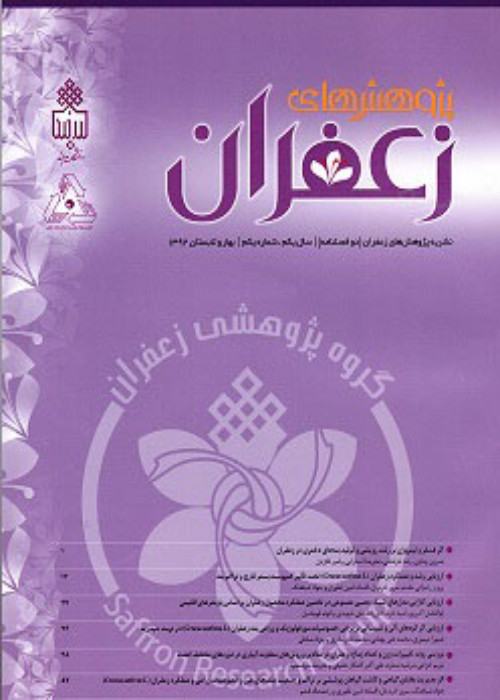Optimization of Manure and Potassium Fertilizers in Saffron Cultivation by Using Surface-Response Methodology
More specifically, the excessive use of inorganic fertilizers has reduced yield and nutrients efficiency of use and intensified nutrient losses in agroecosystems. Optimization is a modelling techniques approach to improve nutrient efficiency of use and mitigate environmental losses. Response surface methodology (RSM) is a statistical technique which is widely used in engineering and scientific disciplines to optimize processes and improve product quality. George Box and his colleagues developed response surface methodology (RSM) during the 1950s. The combination of experimental design, modeling techniques, and optimization methods in response surface methodology (RSM) provides a robust approach that leverages experimental data to achieve process improvements. The experimental design phase of RSM involves planning and conducting experiments to generate data that can be used to build a mathematical model of the relationship between the process parameters and the response variable(s) of interest. In this study, the optimization of cow manure and sulfate potassium fertilizers as two effective fertilizers in saffron production on yield, yield components of flower and corms of saffron was evaluated by using RSM.
An experiment was conducted with 13 treatments and two replications at the Agricultural Research Field, Ferdowsi University of Mashhad, during two growing seasons of 2017-2018 and 2018-2019. The treatments were allocated based on low and high levels of cow manure (0 and 100 t. ha-1, respectively) and sulfate potassium (0 and 400 kg per ha, respectively). Flower yield indicators (such as fresh weight of flower, flower numbers and dried weight of stigma per unit) and daughter corm criteria (including daughter corm numbers per unit, dried weight of daughter corms per unit and daughter corm diameter) in the second year of experiment were computed as dependent variables and changes of these variables were evaluated by a regression model. The adequacy of the model was judged using analysis of variance, lack-of-fit test, determination coefficient (R2) and root mean square error (RMSE). Finally, the optimum levels of cow manure and potassium sulfate were calculated based on economic scenario for dependent variables such as stigma yield, daughter corm yield and daughter corm diameter and desirability index (D).
The experimental results revealed that the effect of linear component was significant on flower numbers, fresh weight of flower and daughter corm diameter. Effect of square component was significant on flower numbers and fresh weight of flowers. Interaction effect of full quadratic component was significant on dried weight of daughter corms. Lack-of-fit test had no significant effect on the studied traits that represent the full square model was satisfactorily explained. The maximum observed values for fresh weight of flower and flower numbers were recorded for 100 t cow manure per ha+ without any potassium sulfate consumption with 15.15 g. m-2 and 33 flowers. m-2, respectively. The highest dried weight of daughter corms was observed in 100 t cow manure per ha+ 400 kg potassium sulfate per ha with 314.28 g. m-2. The estimated optimization rates for manure and potassium sulfate were 80.50 t. ha-1 and 371.71 kg. ha-1 (with D= 0.98), respectively.
RSM is defined as a collection of statistical techniques that are used to optimize production inputs. RSM involves the design and analysis of experiments, modeling techniques, and optimization methods to find the optimal combination of process parameters that will yield the highest quality product or process output. The optimization phase involves using the mathematical model to identify the optimal process parameters that will yield the desired response variable(s). One of the key advantages of RSM is that it enables engineers and scientists to optimize complex processes with multiple input variables. RSM can also help reduce the number of experiments required to optimize a process, which can save time and resources. Additionally, RSM can help identify the interactions between different process parameters, which is useful for gaining a deeper understanding of the underlying process and for making further process improvements. Results demonstrate that for each response, different parameters and interactions were important. Therefore, to optimize parameters (such as cow manure and sulfate potassium), corm yield and stigma yield should be considered simultaneously. In general, it seems that optimization of resource use based on response-surface methodology may be suitable cropping approach for sustainable production, yield improvement and mitigation of environmental pollution in saffron cultivation.
- حق عضویت دریافتی صرف حمایت از نشریات عضو و نگهداری، تکمیل و توسعه مگیران میشود.
- پرداخت حق اشتراک و دانلود مقالات اجازه بازنشر آن در سایر رسانههای چاپی و دیجیتال را به کاربر نمیدهد.



